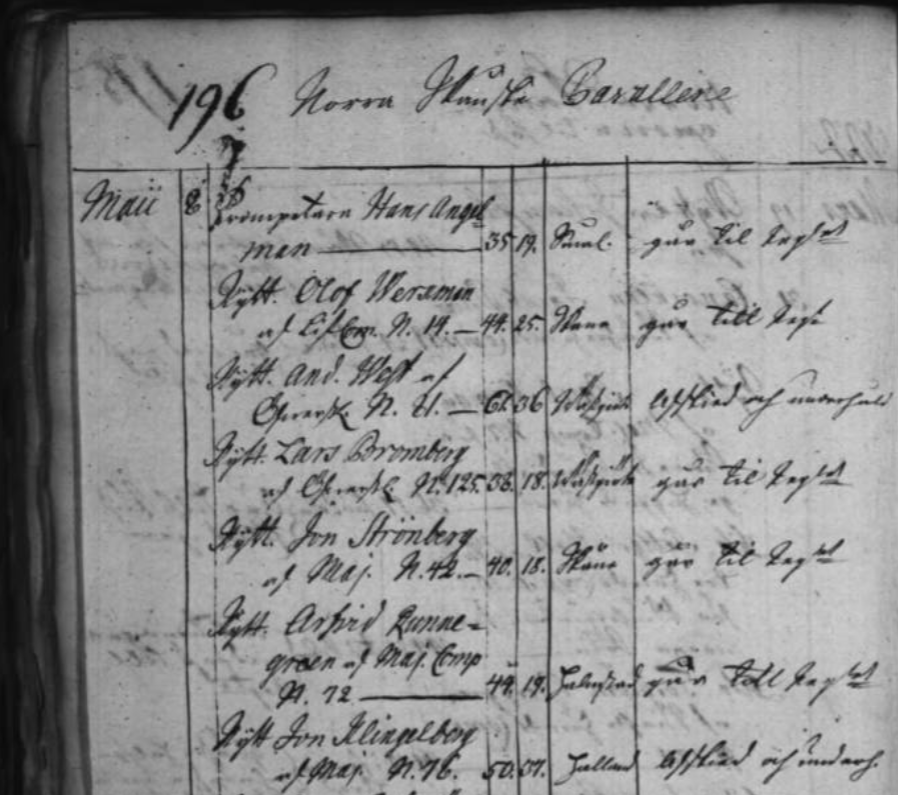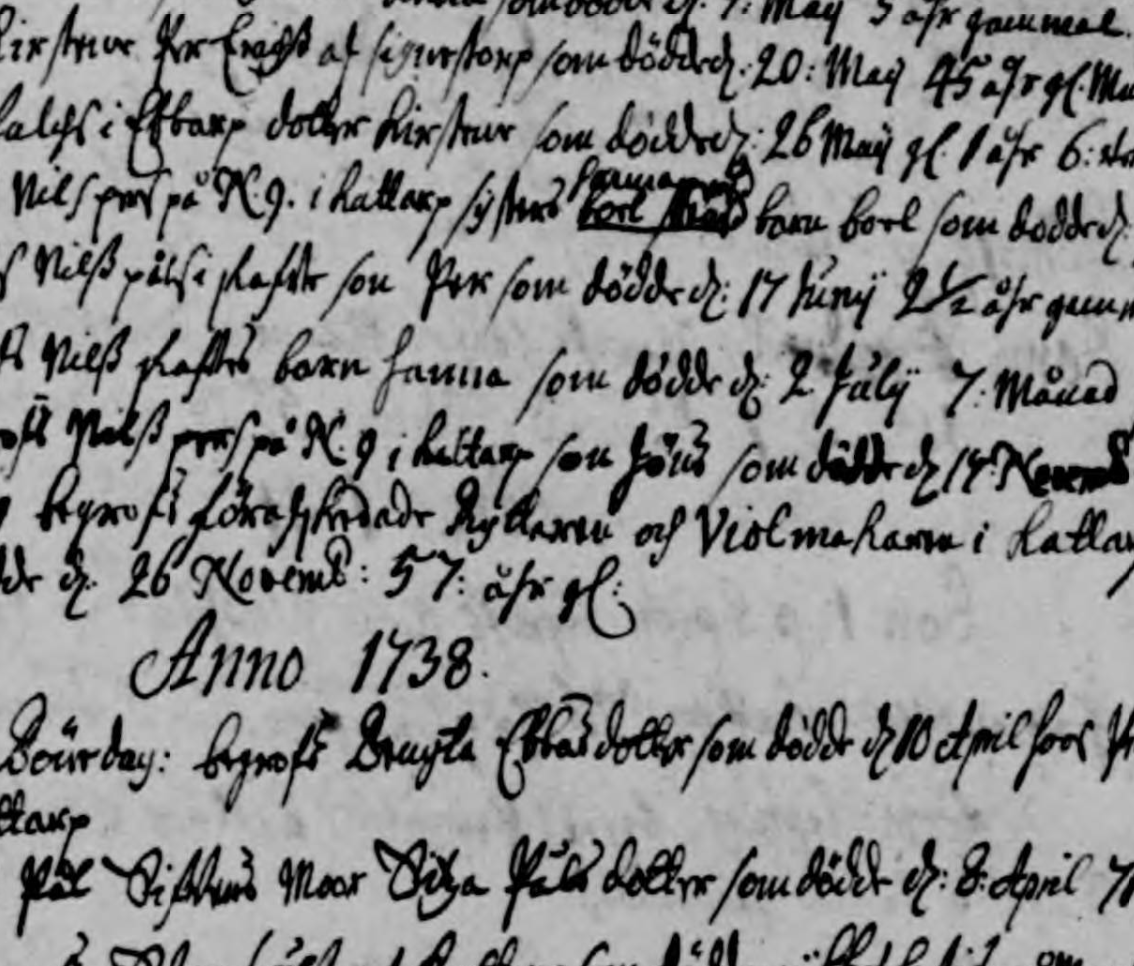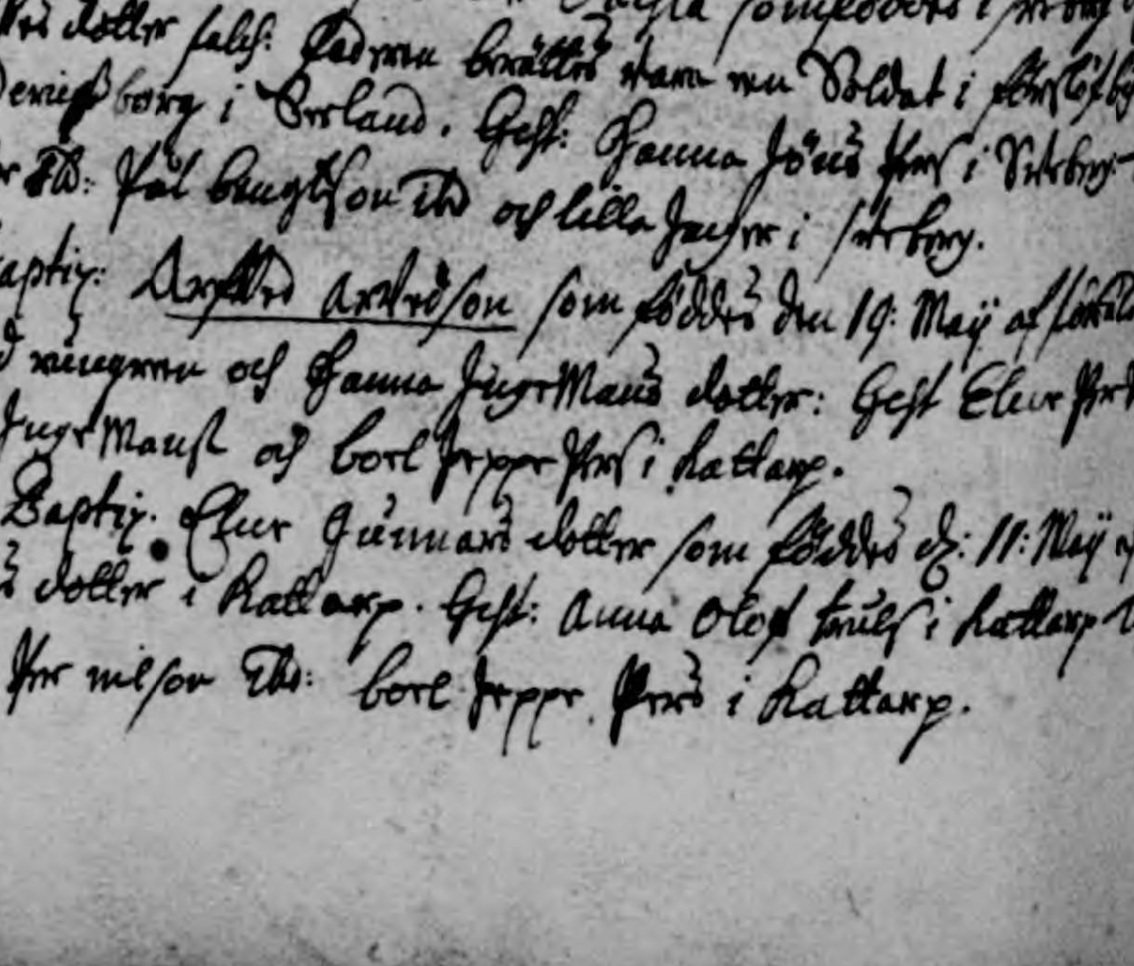
- Start
- Double-deckers
- Other swedish understringed fiddles
- Luthiers
- Arwit Rönnegren
- Johan Georg Mothe
- Hans Severin Nyborg
- Other instruments with sympathetic strings
- References to violins with sympathetic strings
- Other instruments
- Contemporary fiddles
- Blog
- Origin of sympathetic strings
- Construction guides
- Search picture
- About me
- Bror Strand
Arwit Rönnegren
In 1701 and 1702 Arwit Rönnegren is listed under the heading Trådz Drängiar (i.e. as a servant in the entourage or contingent connected to the army) in rolls (lists of military staff) of the Norra Skånska Kavalleriregementet (Northern Scanian Cavalry Regiment), which was then stationed in Pomerania. Also a Nills Rönnegren is listed there and it is not too wild a guess that this was Arvid's brother. On December 6, 1699, the Northern Scanian Cavalry Regiment received a order to get ready to be sent to war and in the summer of 1700 it was moved to Ystad, a harbor city on the Swedish south coast. During 1701 and 1702 the regiment was moved to Swedish Pomerania where, together with the Pomeranian Cavalry Regiment, it was garrisoned in cantonal quarters in Stralsund and west of Greifswald. The regiment was later part of the army under the command of General Baron Nils Gyllenstierna, which in August 1702 joined Charles XII's main army near Krakau (Krakow) end later engaged in the war against August the Strong's Saxony/Poland. In 1704 the Northern Scanian Cavalry Regiment got a new commander in the form of Gustaf Horn af Marienburg and they participated in many battles in Poland over the next few years and were also left there as a garrison when the main army entered Saxony in 1706. During this period, Arvid Rönnegren must have been promoted to Ryttare (i.e. private cavalryman) since that is his title in the list/roll over homecoming prisoners of war. He returned on May 8, 1722 and the documentation specifies that Rönnegren is 44 years old and has served for 19 years, which suggests that he would have been promoted to Ryttare in 1703 (with the assumption that the years as a servant in the regiment entourage were not counted) and was born in 1678, which does not entirely match the death and burial book from Kattarp. The Northern Scanian Cavalry Regiment participated in the Battle of Poltava and surrendered with the remnants of the Swedish army, then led by Adam Ludvig Lewenhaupt, at Perevolochna. After the surrender the entire Swedish army were moved to Moscow where Czar Peter forced them to join a humiliating walk of shame before the prisoners were scattered to different towns all over the Russian Empire.
Litterature about the captured Caroleans is rather focused on the prisoners in Tobolsk and a few other towns in Siberia. Most of the officers were sent to Siberia to be far away from Sweden since the Russians were more worried that the officers would escape home or organize rebellions than lower ranked soldiers. The officers were better educated and has left more written records and thus are easier to write about and you can also get the impression that most soldiers spent their captivity in Siberia. In total numbers there were more Caroleans in the European part of Russia where they were forced to hard labour such as building the new city of St. Petersburg. Arwit Rönnegren is found in a list of participants of a communion ceremony in Moscow on June 27, 1718 together with only three other soldiers from the North Scanian Cavalry Regiment. Fellow violin maker Johan Georg Mothe is also found in this record and the best guess is that Rönnegren and Mothe spent all or large parts of their captivity in Moscow. Rönnegren is also listed in two rolls in Thomas Knipercrona's embassy documents from Moscow. The first roll is from January 1722 and the other might be some kind of list of people gathered in Moscow before for the departure back home. Runnegren (this time called Rundegren) was listed together with his wife and with one mark for a man and one for a woman in the columns of the people not rebaptized (converted to orthodox Christianity.
There are no indications in the church records that suggests Arwit Rönnegren have married before leaving Sweden 1701. It is however a bit unclear where he lived before 1701, he was born in Halmstad but his regiment was based in Helsingborg and as a servant in the regiment entourage he was not eligible for a soldier croft. I would guess he was recruited in Halmstad and sent to Pomerania almost immediately. Scanians were not allowed to be part of the Scanian regiments before the Great Northern War because they were considered unreliable and they therefore recruited people in Halland, Småland and Västergötland. I don't think that Rönnegren can be found in a marriage record from Halmstad before 1701 either and I would guess that he married during his captivity in Russia. There were women among the civilians who followed the army (the tross or entourage) and they also ended up in captivity and it has been desirable for the soldiers to be able to marry during the long years in Russia. Rönnegren's wife is almost 20 years older than him but there are indications that Rönnegren had been injured in combat and an older but healthy woman and a younger but injured man might have been considered a reasonable match. Most prisoners seem to have travelled home via Moscow, and Knipercrona's rolls contain many more soldiers from Norra Skånska than the communion protocol does. I interpret this to mean that Rönnegren and a few others had stayed in Moscow in 1718, but that in January 1722 many more members of the regiment had gathered there for the journey home. Carl Piper, king Charles XII's most important adviser and a prisoner in Moscow from 1709 to 1714, wrote in a letter home to his wife Christina:
I have reason to praise the officers, who do everything in their ability to survive and make a living. In the autumn they assist peasants during harvest, they carry salt, collect lumber, they make spinets, violets, playing cards and other things, they act as fencing masters, dance masters and praeceptors, but can with difficulty earn only 2 copeks a day, barely sufficient for food, but not enough for the clothing.
This is further evidence that Rönnegren and Mothe may have stayed in Moscow, as it is more likely that Piper picked up their instrument making there than elsewhere. Piper describes the occupation of officers, but I don't think it was culturally possible for someone like Piper to even mention commoners or farmhands in a letter home to his wife. There are no currently no other Caroleans known for violin building so my assumption is that it is Rönnegren and Mothe that Piper is writing about.

Rönnegren is found in a roll of returned prisoners of war where it is stated that he returned on May 8, 1722. The roll has been written in Stockholm since it deals with all regiments, but it is a bit unclear exactly what happened on May 8th. Has Rönnegren been in Stockholm on this day or back at the regiment in Skåne? A source at Krigsarkivet (the Swedish Military Archives) believes that the rolls of returned prisoners are compiled in Stockholm based on information obtained from the regimental and that May 8th is the date when the information from the regiment reached Stockholm. Articles on the subject of the Caroleans' journey home states that all Caroleans, except those who were going to their homes in Finland or one of the Baltic provinces, arrived by boat to Stockholm. If that is true I would guess Rönnegren was in Stockholm on May 8, 1722. It is interesting to note that a Jon Klingelberg is also included in the roll of returned prisoners, because he is, like Rönnegren, one of the witnesses that Johan Georg Mothe uses when he applies to settle in Ängelholm and who is supposed to certify that Mothe is a man of record. Even though Mothe does not appear in the same list it is assumable that he traveled to Sweden among Rönnegren and Klingelberg since those were his witnesses and Klingelberg is not in the communion protocol from Moscow and might have spent his captivity elsewhere and Mothe might have gotten to know Klingelberg through Rönnegren on the journey. In the roll of returnees it says that Rönnegren goes to the regiment, which means that he returns to service with the Northern Scanian Cavalry Regiment and he is listed in rolls of Norra Skånska until 1737 when it is stated that he was "discarded" in 1732 and replaced with another soldier. The first roll after his return, which dates back to 1722, states that the cavalryman Arfved Runnegren has been ordered by the military administration to resume his former soldier number. A soldier's croft/cottage was linked to a number or rank in the regiment and the soldiers usually moved to another house if they were promoted. If Rönnegren got his number when he was upgraded from servant to cavalryman, he had probably never taken possession of the croft since he was abroad, and may well have seen it for the first time in 1722. The 26-year-old Scanian Oluf Lindh, who had lived in the croft for five years, then had to move in favour of his 45-year-old colleauge who had never been to Ebbarp but who had the possession rights thanks to the correct administrative number.
Violin making was just a side business for Arvid Rönnegren except for perhaps the last five years of his life. The oldest preserved instrument after Rönnegren dates back to 1724, which makes it unlikely, although not impossible, that he could have learned violin building from Mothe after coming back to Sweden. I believe Rönnegren and Mothe learned the violin making skills at the same time as they are found in the same communion protocol and both quite immediately get started with instrument making after arriving in Skåne.

Arvid's wife Anna Gabrielsdotter was 22 years older than her husband and the couple both died in 1737 when Anna was 79 years old and Arvid was 57. Despite this, Arvid managed to find a new woman and marry her after the death of his first wife. Hanna Ingemansdotter gave birth to a son, Arfved Arvedson, May 19, 1738 but at that point the father Arwit Rönnegren was already dead.

| Instrument av Arwit Rönnegren |
| Bulan |
| Jamtlifiolen |
| Bostongamban |
| Kulturenfiolen |
| Arwitgamban M285 |